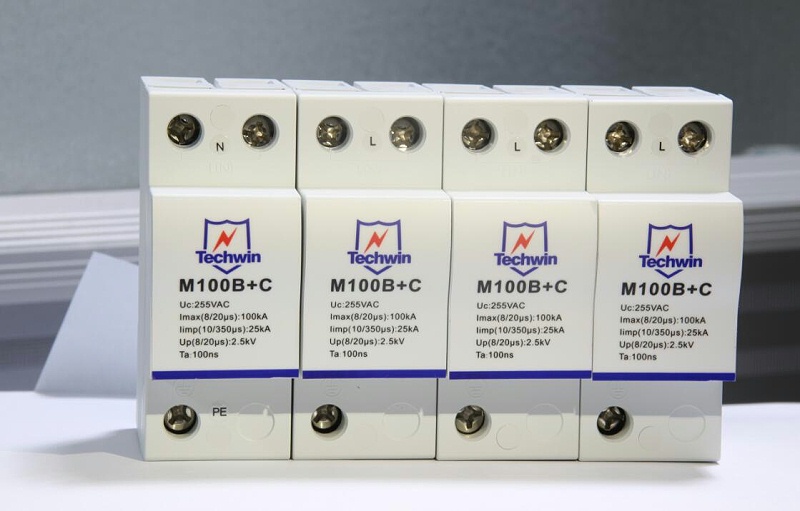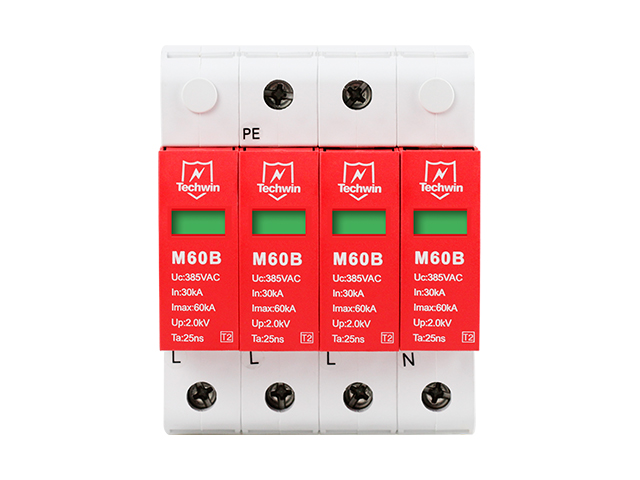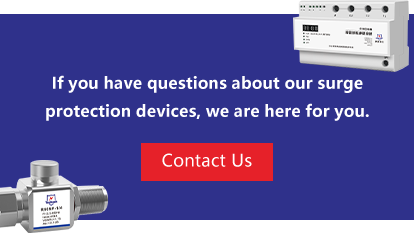A surge protector, also known as a lightning arrester, is an electronic device that provides safety protection for various electronic devices, instruments, and communication lines. When a sudden spike in current or voltage occurs in an electrical or communication circuit due to external interference, the network surge protector can quickly conduct and shunt, thereby avoiding damage to other devices in the circuit caused by surges.
A surge protector is suitable for protecting against surges caused by indirect or direct lightning strikes or other transient overvoltages in power supply systems with an alternating current of 50/60HZ and a rated voltage of 220V/380V. It is suitable for the surge protection requirements of residential properties, tertiary industries, and industrial fields. Regardless of where it is used, a signal surge protector is an indispensable asset for protecting electrical equipment from damage and ensuring their operational reliability. With high-quality surge protection devices from reputable brands, it is possible to safeguard electrical systems and minimize the risks of power damage or failure, providing peace of mind to users and helping to maintain the integrity of electrical systems.

For customers who are working on projects and need to know which model of surge protector to use for distribution boxes, they first need to know the level of distribution and whether a high-end surge protector has been installed on the main distribution before the distribution box. Generally, a level one surge protector (M100B+C/3+N) is required for the main distribution, and a level two or three surge protector (M40B4) is required for the distribution box.
Secondly, the installation location of the distribution box needs to be considered. If it is installed outdoors, a level one surge protector is necessary. If it is a distribution box for equipment, it should be a level three surge protector, but if outdoor wiring is used, it is recommended to choose a level one surge protector (M100B+C/3+N) because it has a long service life and good protective effect.

Finally, surge protectors should be installed on the incoming cabinet and other cabinets in areas where thunderstorms are likely to occur. A level one surge protector with a maximum discharge current greater than 60KA (M60B4) should be selected for the incoming cabinet, and 20-40KA surge protectors can be selected for other cabinets. If the area does not have a high probability of thunderstorms, surge protectors can be installed in the incoming cabinet or special equipment. The models of high-end surge protectors are named by the manufacturer according to their parameters, and each surge protection devices manufacturer has different naming rules and model numbers.
The earliest type of surge protector was the lamb horn gap, which appeared in the late 19th century and was used for overhead transmission lines to prevent power outages caused by damage to equipment insulation by lightning strikes. In the 1920s, aluminum surge protectors, oxide film surge protectors, and pellet-type surge protectors appeared. In the 1930s, tube-type surge protectors appeared. In the 1950s, silicon carbide lightning arresters appeared. In the 1970s, metal oxidenetwork surge protectors appeared. Modern high-voltage surge protectors are not only used to limit overvoltage caused by lightning strikes in power systems, but also to limit overvoltage caused by system operations. Since 1992, industrial control standards represented by German and French 35mm rail-mounted pluggable SPD lightning protection modules began to be imported into China on a large scale, and later, integrated box-type power lightning protection combinations represented by the United States and the United Kingdom also entered China.
 Detailed Explanation of Tiered Surge Protection for Distribution BoxesAugust 11, 2025In lightning protection, the surge protection device in distribution boxes plays a crucial role. According to the principle of graded lightning protection, and based on the likelihood of a building be...view
Detailed Explanation of Tiered Surge Protection for Distribution BoxesAugust 11, 2025In lightning protection, the surge protection device in distribution boxes plays a crucial role. According to the principle of graded lightning protection, and based on the likelihood of a building be...view Important differences between IEC 61643-01:2024 and IEC 61643-11:2011: ---Interpretation of the new standard for surge protectorsDecember 12, 2024The surge protector is an electronic device that provides safety protection for various electronic equipment, instruments, and communication lines. According to its use, it can be divided into power s...view
Important differences between IEC 61643-01:2024 and IEC 61643-11:2011: ---Interpretation of the new standard for surge protectorsDecember 12, 2024The surge protector is an electronic device that provides safety protection for various electronic equipment, instruments, and communication lines. According to its use, it can be divided into power s...view How to Choose the SPD for Solar?June 26, 2024Are you worried that expensive photovoltaic solar systems might be damaged by voltage spikes? The reality is that without surge protection, even the slightest voltage spike can damage your solar panel...view
How to Choose the SPD for Solar?June 26, 2024Are you worried that expensive photovoltaic solar systems might be damaged by voltage spikes? The reality is that without surge protection, even the slightest voltage spike can damage your solar panel...view Application of Surge Protector Against LightningNovember 9, 20211. The development of the surge protector against lightningAs early as the 1950s and 1960s, surge protectors have been widely used in lightning protection design. Surge protectors were first called vo...view
Application of Surge Protector Against LightningNovember 9, 20211. The development of the surge protector against lightningAs early as the 1950s and 1960s, surge protectors have been widely used in lightning protection design. Surge protectors were first called vo...view Principle and Function of Signal Surge Protective DeviceMarch 18, 2025Working Principle of Signal Surge Protective DevicesSignal surge protective devices form a protective barrier by connecting in series between the signal channels and the equipment. When a surge voltag...view
Principle and Function of Signal Surge Protective DeviceMarch 18, 2025Working Principle of Signal Surge Protective DevicesSignal surge protective devices form a protective barrier by connecting in series between the signal channels and the equipment. When a surge voltag...view What is A Surge protective device(SPD)? How to install it in an AC power system?April 16, 2025A Surge Protective Device (SPD) is a critical component designed to safeguard electrical systems and equipment from voltage surges caused by lightning strikes, power grid fluctuations, or switching tr...view
What is A Surge protective device(SPD)? How to install it in an AC power system?April 16, 2025A Surge Protective Device (SPD) is a critical component designed to safeguard electrical systems and equipment from voltage surges caused by lightning strikes, power grid fluctuations, or switching tr...view